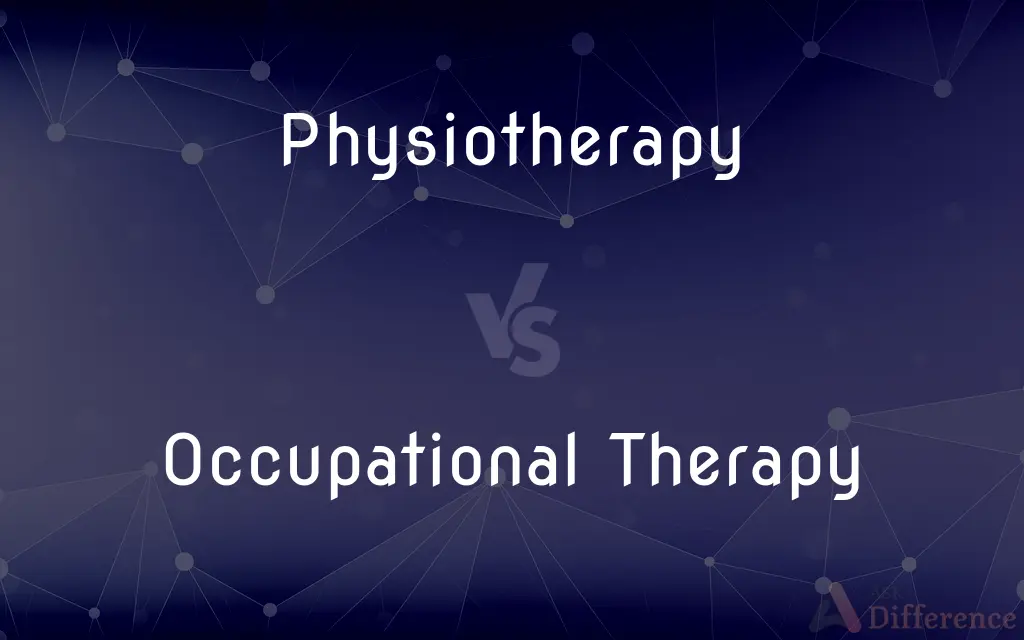Physiotherapy vs. Occupational Therapy — What's the Difference?
By Maham Liaqat & Urooj Arif — Published on October 12, 2024
Physiotherapy focuses on improving physical function and mobility through exercises and treatments, while occupational therapy aims at enhancing individuals' ability to perform daily activities and tasks, considering both physical and cognitive aspects.

Difference Between Physiotherapy and Occupational Therapy
Table of Contents
ADVERTISEMENT
Key Differences
Physiotherapy primarily addresses the physical aspects of rehabilitation, emphasizing the restoration, maintenance, and improvement of a patient's physical strength, mobility, and function. It utilizes techniques such as exercises, manual therapy, and modalities like heat or cold therapy. On the other hand, occupational therapy takes a more holistic approach, focusing not only on the physical recovery but also on enabling individuals to perform daily tasks and activities, considering their physical, emotional, and social needs.
While physiotherapists develop treatment plans to alleviate pain, prevent disability, and improve physical function, occupational therapists design interventions to help patients adapt to their environment, modify tasks, use assistive devices, and regain independence in daily living activities. This might include personal care, work-related tasks, and leisure activities.
Physiotherapy is often sought after injuries, surgeries, or chronic conditions affecting movement and physical function, such as back pain, arthritis, or neurological disorders like stroke. Occupational therapy, however, is broader, assisting those who have experienced a change in ability due to physical injury, illness, psychological or developmental disorders, aiming to enhance their independence in all facets of life.
The techniques in physiotherapy can include exercises for strength and flexibility, joint mobilization, electrical stimulation, and ultrasound therapy, focusing on specific areas of the body. Occupational therapy might involve assessments of the patient's home and work environments, recommendations for adaptive equipment, cognitive exercises, and training in the use of assistive devices, addressing the patient's overall lifestyle.
Both professions aim to improve quality of life, while physiotherapy does so through improving physical abilities and function, whereas occupational therapy focuses on enabling individuals to perform daily activities and tasks, reflecting a broader scope that encompasses physical, cognitive, and environmental factors.
ADVERTISEMENT
Comparison Chart
Focus
Physical function and mobility
Daily activities and overall functionality
Techniques
Exercises, manual therapy, modalities
Activity adaptation, environmental modification
Goal
Improve strength, mobility, and alleviate pain
Enhance ability to perform daily tasks
Typical Conditions
Injuries, post-surgery, chronic pain
Physical, cognitive, developmental disorders
Approach
Targeted physical improvement
Holistic, encompassing physical, cognitive aspects
Compare with Definitions
Physiotherapy
Utilizes exercises and manual therapy techniques.
The physiotherapy session included muscle-strengthening exercises.
Occupational Therapy
Involves training in the use of assistive devices.
He learned to use a mobility scooter through occupational therapy.
Physiotherapy
Aims to alleviate pain and improve physical function.
Regular physiotherapy has helped reduce his chronic back pain significantly.
Occupational Therapy
Focuses on adapting tasks and environments.
The occupational therapist recommended kitchen tools to assist with her arthritis.
Physiotherapy
Can be specialized in areas like sports, neurology, or orthopedics.
She consulted a sports physiotherapist for her running injury.
Occupational Therapy
Addresses cognitive, physical, and emotional challenges.
Occupational therapy sessions included memory exercises for cognitive rehabilitation.
Physiotherapy
Often involves the use of therapeutic modalities.
The physiotherapist used ultrasound therapy to treat the soft tissue injury.
Occupational Therapy
A profession aiding people in performing daily tasks.
Occupational therapy helped him adapt his home for better independence after the stroke.
Physiotherapy
A healthcare profession focused on physical rehabilitation.
After her knee surgery, she started physiotherapy to regain full mobility.
Occupational Therapy
Works with individuals across the lifespan.
Occupational therapy provided strategies for her child with developmental delays.
Physiotherapy
Therapy that uses physical techniques such as massage, ultrasound, heat, and exercise.
Physiotherapy
Therapy that uses physical agents: exercise and massage and other modalities
Common Curiosities
What might an occupational therapist assess?
They might assess a patient's home and work environments, daily activities, and cognitive functions to recommend necessary adaptations.
How does occupational therapy help individuals?
By enhancing their ability to perform daily activities and tasks, considering their physical, emotional, and social needs.
Is physiotherapy only for injury recovery?
While it's commonly used for injury recovery, physiotherapy also addresses chronic conditions, post-surgery rehabilitation, and preventive care.
Do I need a referral for physiotherapy or occupational therapy?
It depends on your location and healthcare system; in some cases, you might need a referral from a doctor.
How long does a typical therapy session last?
Sessions can vary but typically last between 30 to 60 minutes for both physiotherapy and occupational therapy.
What is the main goal of physiotherapy?
To improve physical function, mobility, and alleviate pain through exercises and therapeutic techniques.
What education is required for physiotherapists and occupational therapists?
Both professions typically require a master's or doctoral degree in their respective fields.
Can physiotherapy help with neurological conditions?
Yes, physiotherapy can help manage and improve symptoms related to neurological conditions like stroke or Parkinson's disease.
What's the difference between an occupational therapist and a physical therapist?
Physical therapists focus on improving physical function and mobility, while occupational therapists help individuals perform daily activities and adapt to their environments.
Can occupational therapy help with mental health?
Yes, occupational therapy can address mental health by facilitating engagement in meaningful activities, improving life skills, and adapting environments.
Can I receive both physiotherapy and occupational therapy?
Yes, it's not uncommon for individuals to receive both, especially following injuries or surgeries, to address both physical recovery and functional abilities.
Can children benefit from occupational therapy?
Yes, children with developmental challenges, disabilities, or injuries can benefit significantly from occupational therapy.
How effective is occupational therapy for seniors?
It can be highly effective, helping seniors adapt to physical changes, maintain independence, and improve their quality of life.
Is physiotherapy covered by insurance?
Coverage can vary, but many insurance plans include physiotherapy; it's best to check with your provider.
Can occupational therapy help after a stroke?
Yes, it can be crucial in helping individuals regain independence and adapt to new ways of performing daily tasks after a stroke.
Share Your Discovery

Previous Comparison
Formal Assessment vs. Informal Assessment
Next Comparison
Horse vs. ZebraAuthor Spotlight
Written by
Maham LiaqatCo-written by
Urooj ArifUrooj is a skilled content writer at Ask Difference, known for her exceptional ability to simplify complex topics into engaging and informative content. With a passion for research and a flair for clear, concise writing, she consistently delivers articles that resonate with our diverse audience.












































